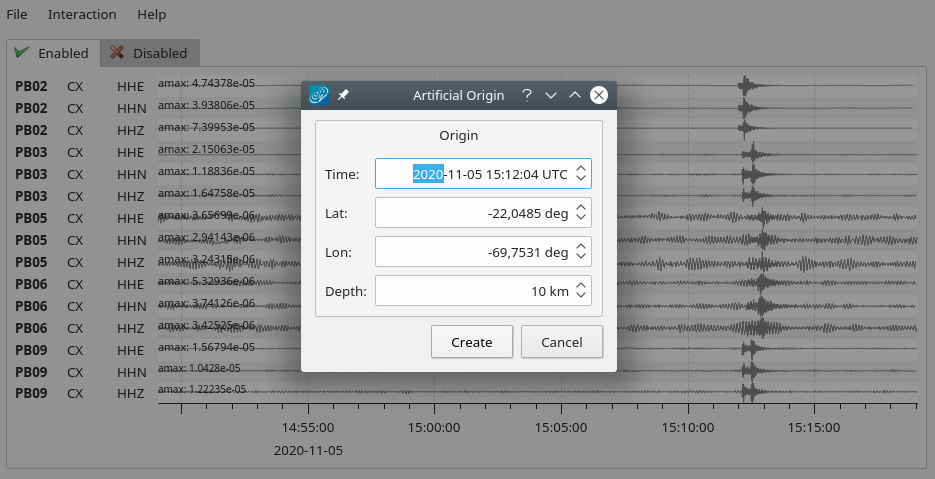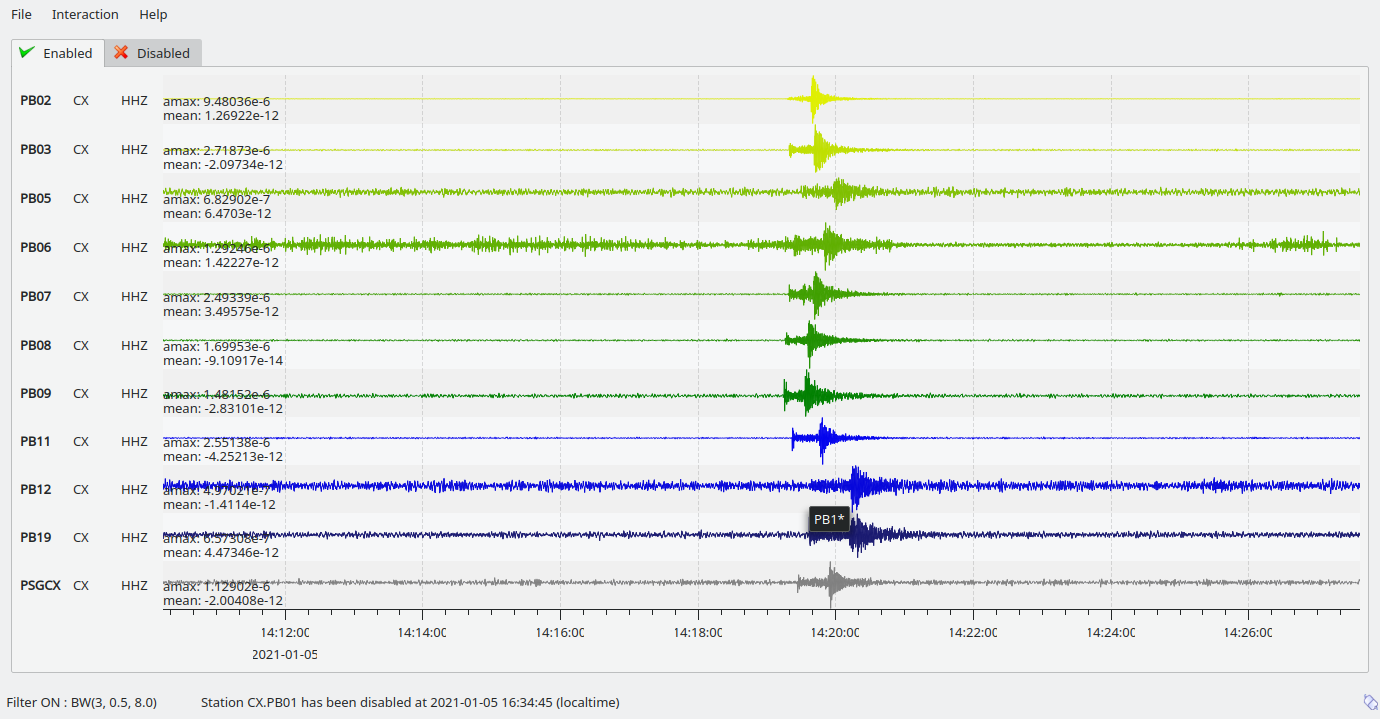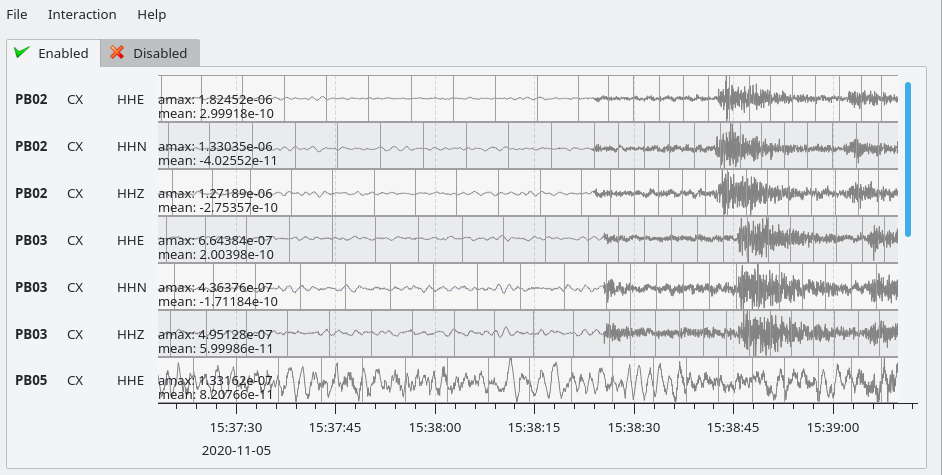scrttv¶
Real-time trace view.
Description¶
scrttv visualizes real-time waveform data (see scrttv overview) of a defined window length (default=30 minutes) and of defined streams/stations (default is primary station channels). scrttv switches between two modi. In the normal mode the trace order is given by the configuration file. In the event mode the traces are sorted by epicentral distance to the latest origin received from the messaging. Additional to the waveform traces information about gaps, picks and the time of incoming origins are displayed.

scrttv overview¶
An example of scrttv and the dialog window to set preliminary origin. Tab 1-2 = enable/disable tab; Counts = maximum counts of a stream; Info = stream information (station, network and channel code); Filter = filter status of the traces; Status = connection status.
scrttv shows two tabs: the enabled and the disabled tab (see scrttv overview: Tab 1-2). Stations listed in the disabled tab are excluded from processing (e.g. picking). To move a station from one tab to another just drag and drop the trace to the new tab. An alternative solution is to double click on the trace label to disable a trace.
Normally, the raw data are displayed. Pressing f the predefined bandpass filter of third order from 0.5 Hz to 8 Hz, BW(3,0.5,8) is applied to the traces. Also zoom functions for the time and amplitude axis are provided.

Artifical origin.¶
In case the operator recognizes several seismic signals, an artificial/preliminary origin can be set by either pressing the middle mouse button on a trace or by opening the context menu (right mouse button) on a trace and selecting “Create artificial origin”. The following pop-up window shows the coordinates of the station and the time the click was made on the trace. Both are used to generate the new artificial origin without any arrivals. Pressing “Create” sends this origin to the LOCATION group. This artificial origin is received e.g. by scolv and enables an immediate manual analysis of the closest traces.
Among the configurable parameters are:
Global bindings:
default definition of traces to show (
detecStreamanddetecLocid).
Module configuration:
network, stations, locations and streams to show extending or overriding the default definition (
streams.codes),buffer size controlling the lenght of loaded data (
bufferSize),sorting of traces upon arrival of new origins (
resortAutomatically),reference coordinate for sorting traces by default (
streams.sort.*),region filters (
streams.region.*),grouping of streams with different properties,
number of traces to show with fixed height (
streams.rows).
Scheme parameters in global module configuration:
trace properties and trace background colors,
font and general GUI parameters.
More parameters are available on the command-line:
scrttv -h
Enable / Disable Stations¶
To enable or disable a station for automatic data processing in SeisComP select a station code with the mouse and drag the stations to the disable / enable tab or simply double-click on the station code.
Stream Filtering¶
scrttv allows filtering of waveforms.
The hotkey f can be used to
toggle the list of filters pre-defined in filter or in filters.
Note that the list of filters defined in filters overwrites filter.
Activate autoApplyFilter to filter all traces at start-up of scrttv
with the first filter defined in filters.
The applied filter is shown in the lower left corner (see Figure below).
To show filtered and raw data together use the hotkey r.
Stream Grouping¶
scrttv allows grouping of stations and even streams with different properties, e.g. colors or color gradients.

Stations with 2 groups and different line color gradients. Ungrouped stations
are visible with default line properties. The applied filter
is shown in the lower left corner. The tooltip on top of station CX.PB19
is derived from streams.group.$name.title.¶
Configuration
Adjust the scrttv module configuration (scrttv.cfg).
Define the groups:
add a new group profile to
streams.group.set the properties for this group profile. Colors and color gradients are defined by hexadecimal values or by color keyword names. When choosing gradients the colors of the traces within one group will be varied in alphabetic order of the streams.
set a group title in
streams.group.$name.title.
Register the groups in
streams.groups.
Viewing groups
Open scrttv to view the data.
Select Sort by group in the Interaction menu or use the hotkey 5 to sort the traces by their groups.
Mouse over a station belonging to a group. The tooltips shows the group title.
For maintaining the sorting by groups adjust the scrttv module configuration (
scrttv.cfg):resortAutomatically = false
Record Borders¶
The borders of records are toggled by using the hotkey b.

Record borders in box mode on top of waveforms.¶
Border properties can be adjusted and signed records can be visualized by colors
configured in the scheme parameters in global.cfg or scrttv.cfg:
scheme.records.borders.drawMode: Define where to draw borders, e.g. on top, bottom or as boxes.scheme.colors.records.borders.*: Define pen and brush properties.
Offline Mode¶
To start scrttv without connection to the messaging use the option --offline
or simply provide the miniSEED data file, e.g.:
scrttv [your miniSEED file]
In offline mode event parameters given in SCML files, e.g. from offline processing, can be loaded using the File menu.
Hotkeys¶
Hotkey |
Description |
|---|---|
F1 |
Open SeisComP documentation |
Shift+F1 |
Open scrttv documentation |
F2 |
Setup connection dialog |
F11 |
Toggle fullscreen |
c |
Clear picker markers |
b |
Toggle record borders |
h |
List hidden streams |
n |
Restore default display |
o |
Align by origin time |
Alt+q |
Quit |
Filtering |
|
f |
Toggle filter |
r |
Toggle all records |
Navigation |
|
Ctrl+f |
Search traces |
up |
Line up |
down |
Line down |
PgUp |
Page up |
PgDn |
Page down |
Alt+PgUp |
To top |
Alt+PgDn |
To bottom |
left |
Scroll left |
right |
Scroll right |
Ctrl+left |
Align left |
Ctrl+right |
Align right |
Sorting |
|
1 |
Restore configuration order of traces |
2 |
Sort traces by distance |
3 |
Sort traces by station code |
4 |
Sort traces by network-station code |
5 |
Sort traces by group |
Zooming |
|
< |
Horizontal zoom-in |
> |
Horizontal zoom-out |
y |
Vertical zoom-out |
Shift+y |
Vertical zoom-in |
Ctrl+mouse wheel |
Vertical and horizontal zooming |
z |
Toggle zoom |
Configuration¶
etc/defaults/global.cfgetc/defaults/scrttv.cfgetc/global.cfgetc/scrttv.cfg~/.seiscomp/global.cfg~/.seiscomp/scrttv.cfgscrttv inherits global options.
-
maxDelay¶ Type: int
Unit: s
If greater than 0 then all traces for which the data latency is higher than this value are hidden. Default is
0.
-
resortAutomatically¶ Type: boolean
If enabled then all traces are sorted by distance when a new origin arrives. Default is
true.
-
showPicks¶ Type: boolean
If enabled, picks are shown. Default is
true.
-
filter¶ Type: string
Defines the filter to be used when filtering is activated. This is only being used if filters is not set otherwise it is overridden. This option is mainly for backward compatibility. Default is
BW(3, 0.5, 8.0).
-
filters¶ Type: list:string
Defines a list of filters that is cycles through when pressing ‘f’. This options supersedes the filter option. If not defined then filter is used instead. If defined then this filter list is used exclusively and the filter option is ignored.
-
autoApplyFilter¶ Type: boolean
Activates the first filter of the configured filter list after startup. This is equivalent to pressing ‘f’. Default is
false.
-
bufferSize¶ Type: int
Unit: s
Defines the buffer size in seconds of the ring bu of each trace. Default is
1800.
-
allTracesInitiallyVisible¶ Type: boolean
If set to true all traces will be visible on application startup independent of data availability. Default is
false.
-
autoResetDelay¶ Type: int
Unit: s
Time span in seconds to switch back to the last view after an origin caused resorting. The default is 15min. Default is
900.
-
streams.codes¶ Type: list:string
The list of channel codes to be displayed. List items may contain wildcards at any position and are separated by comma. The list is intersected with all channels configured in inventory.
Examples:
default : display all streams configured by global bindings
default, PF.BON.00.HH? : display default and all HH streams of PF.BON.00
-
streams.blacklist¶ Type: list:string
If not empty then all stream patterns are part of the blacklist. The blacklist is only active if “streams.codes” is omitted and the default stream list according to the bindings is to be shown. Each pattern can include wildcards (either ? or *). The pattern is checked against the channel id which is a concatenation of network code, station code, location code and channel code separated with a dot, e.g. “GE.MORC..BHZ”.
-
streams.rows¶ Type: integer
Number of rows to show at once in one windows. If more traces than rows are loaded, the are accessible by a scroll bar.
-
streams.groups¶ Type: string
Stream group profiles to be considered. Use comma separation for a list of groups.
Note
streams.sort.* Configures the initial stream sorting.
-
streams.sort.mode¶ Type: string
The sort mode applied initially. Allowed values are: config, distance, station, network, group. Default is
distance.
-
streams.sort.latitude¶ Type: double
Unit: deg
Latitude of the initial location for sorting traces. Only valid if mode == distance. Default is
0.0.
-
streams.sort.longitude¶ Type: double
Unit: deg
Longitude of the initial location for sorting traces. Only valid if mode == distance. Default is
0.0.
Note
streams.region.* Defines a region used for clipping requested stations.
-
streams.region.lonmin¶ Type: double
Unit: deg
Minimum longitude. Default is
-180.0.
-
streams.region.lonmax¶ Type: double
Unit: deg
Maximum longitude. Default is
180.0.
-
streams.region.latmin¶ Type: double
Unit: deg
Minimum latitude. Default is
-90.0.
-
streams.region.latmax¶ Type: double
Unit: deg
Maximum latitude. Default is
90.0.
Note
streams.group.* Definiton of stream groups shown in scrttv with unique features. Register the profiles in “groups” to apply them.
Note
streams.group.$name.*
$name is a placeholder for the name to be used and needs to be added to streams.groups to become active.
streams.groups = a,b
streams.group.a.value1 = ...
streams.group.b.value1 = ...
# c is not active because it has not been added
# to the list of streams.groups
streams.group.c.value1 = ...
-
streams.group.$name.members¶ Type: list:string
List of channels codes to be displayed within this group. List items may contain wildcards at any position and are separated by comma. The list is intersected with all channels configured in inventory.
Example:
CX.*..BH?,PF.BON.00.HH? : all BH streams of the CX network and all HH streams of PF.BON.00
-
streams.group.$name.title¶ Type: string
Title of the group visible as a tooltip of the traces.
Note
streams.group.$name.pen.* Defines the trace pen of the group.
-
streams.group.$name.pen.color¶ Type: color
The color of the pen. If not given, the default trace color is being used. The parameter is overridden by “streams.group.$profile.gradient” .
-
streams.group.$name.pen.gradient¶ Type: gradient
Defines the color gradient used to generate the trace color for each group member. When given, the value in “streams.group.$profile.pen.color” is ignored. The colors are distributed equally and given in hexadecimal representation or by or color keyword names. The stop points can be set at any value. The final trace color will be interpolated from the normalized gradient where the value range is scaled to [0,1].
Format: value1:color1,value2:color2
Examples:
0:yellow,1:green
0:FFBF00,1:C70039
-
streams.group.$name.pen.style¶ Type: string
The style of the pen. Supported values are: NoPen, SolidLine, DashLine, DotLine, DashDotLine, DashDotDotLine. Default is
SolidLine.
-
streams.group.$name.pen.width¶ Type: double
The width of the pen. Default is
1.0.
Command-line¶
Generic¶
-
-h,--help¶ show help message.
-
-V,--version¶ show version information
-
--config-filearg¶ Use alternative configuration file. When this option is used the loading of all stages is disabled. Only the given configuration file is parsed and used. To use another name for the configuration create a symbolic link of the application or copy it, eg scautopick -> scautopick2.
-
--pluginsarg¶ Load given plugins.
-
-D,--daemon¶ Run as daemon. This means the application will fork itself and doesn’t need to be started with &.
-
--auto-shutdownarg¶ Enable/disable self-shutdown because a master module shutdown. This only works when messaging is enabled and the master module sends a shutdown message (enabled with –start-stop-msg for the master module).
-
--shutdown-master-modulearg¶ Sets the name of the master-module used for auto-shutdown. This is the application name of the module actually started. If symlinks are used then it is the name of the symlinked application.
-
--shutdown-master-usernamearg¶ Sets the name of the master-username of the messaging used for auto-shutdown. If “shutdown-master-module” is given as well this parameter is ignored.
Verbosity¶
-
--verbosityarg¶ Verbosity level [0..4]. 0:quiet, 1:error, 2:warning, 3:info, 4:debug
-
-v,--v¶ Increase verbosity level (may be repeated, eg. -vv)
-
-q,--quiet¶ Quiet mode: no logging output
-
--componentarg¶ Limits the logging to a certain component. This option can be given more than once.
-
-s,--syslog¶ Use syslog logging back end. The output usually goes to /var/lib/messages.
-
-l,--lockfilearg¶ Path to lock file.
-
--consolearg¶ Send log output to stdout.
-
--debug¶ Debug mode: –verbosity=4 –console=1
-
--log-filearg¶ Use alternative log file.
Messaging¶
-
-u,--userarg¶ Overrides configuration parameter
connection.username.
-
-H,--hostarg¶ Overrides configuration parameter
connection.server.
-
-t,--timeoutarg¶ Overrides configuration parameter
connection.timeout.
-
-g,--primary-grouparg¶ Overrides configuration parameter
connection.primaryGroup.
-
-S,--subscribe-grouparg¶ A group to subscribe to. This option can be given more than once.
-
--content-typearg¶ Overrides configuration parameter
connection.contentType.
-
--start-stop-msgarg¶ Sets sending of a start- and a stop message.
Database¶
-
--db-driver-list¶ List all supported database drivers.
-
-d,--databasearg¶ The database connection string, format: service://user:pwd@host/database. “service” is the name of the database driver which can be queried with “–db-driver-list”.
-
--config-modulearg¶ The configmodule to use.
-
--inventory-dbarg¶ Load the inventory from the given database or file, format: [service://]location
-
--db-disable¶ Do not use the database at all
Records¶
-
--record-driver-list¶ List all supported record stream drivers
-
-I,--record-urlarg¶ The recordstream source URL, format: [service://]location[#type]. “service” is the name of the recordstream driver which can be queried with “–record-driver-list”. If “service” is not given “file://” is used.
-
--record-filearg¶ Specify a file as record source.
-
--record-typearg¶ Specify a type for the records being read.
Mode¶
-
--offline¶ Do not connect to a messaging server and do not use the database.
-
--no-inventory¶ Do not read streams from inventory but display all streams available from the specified record source. This option may be combined with the streams.codes parameter to filter the available streams.
-
--end-timearg¶ Set the acquisition end time, e.g. ‘2017-09-08 13:30:00’, default: ‘gmt’
-
--buffer-sizearg¶ Sets the size of the waveform buffer in seconds, default: 1800
-
--max-delayarg¶ The maximum delay in seconds to keep a trace visible (0 to disable)
-
--initially-visible-all¶ Overrides configuration parameter
allTracesInitiallyVisible.
-
--rt¶ Don’t ask for time window at data server. This might be important if e.g. Seedlink does not allow time window extraction.